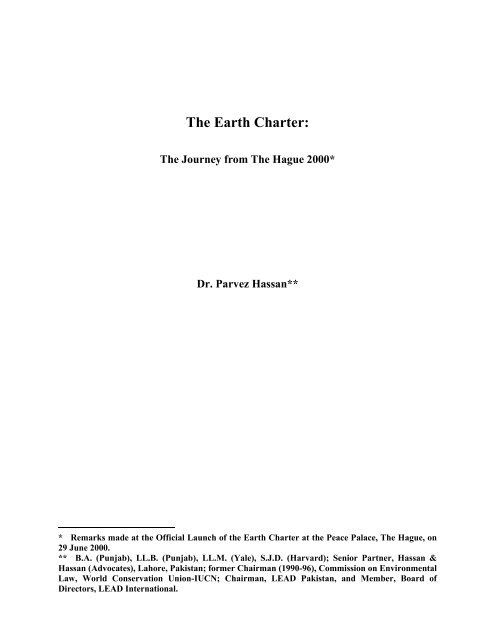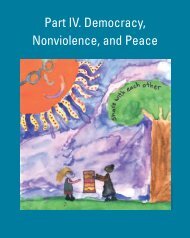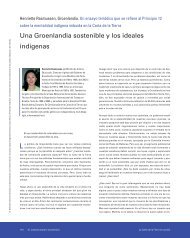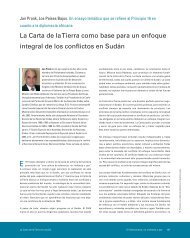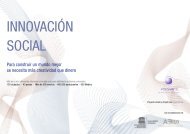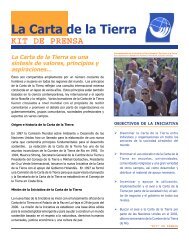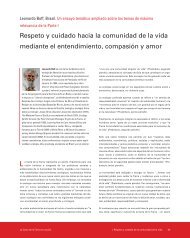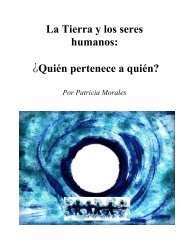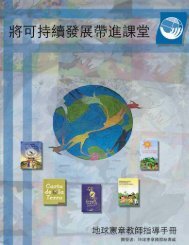Hassan, Parvez - Earth Charter Initiative
Hassan, Parvez - Earth Charter Initiative
Hassan, Parvez - Earth Charter Initiative
- No tags were found...
Create successful ePaper yourself
Turn your PDF publications into a flip-book with our unique Google optimized e-Paper software.
The <strong>Earth</strong> <strong>Charter</strong>:The Journey from The Hague 2000*Dr. <strong>Parvez</strong> <strong>Hassan</strong>*** Remarks made at the Official Launch of the <strong>Earth</strong> <strong>Charter</strong> at the Peace Palace, The Hague, on29 June 2000.** B.A. (Punjab), LL.B. (Punjab), LL.M. (Yale), S.J.D. (Harvard); Senior Partner, <strong>Hassan</strong> &<strong>Hassan</strong> (Advocates), Lahore, Pakistan; former Chairman (1990-96), Commission on EnvironmentalLaw, World Conservation Union-IUC; Chairman, LEAD Pakistan, and Member, Board ofDirectors, LEAD International.
The <strong>Earth</strong> <strong>Charter</strong>: The Journey from The Hague 2000 *Dr. <strong>Parvez</strong> <strong>Hassan</strong> **Inspirational documents have changed the course of events and impacted on human societies: theMagna Carta, the American Declaration of Independence, the French Declaration of the Rightsof Man and of the Citizen, and the Universal Declaration of Human Rights, all stirred humanimagination and changed the quality of life of peoples all over the globe. Today, we gather herein the Peace Palace at The Hague on the invitation of the Co-Chairs of the <strong>Earth</strong> <strong>Charter</strong>Commission, Mikhail Gorbachev and Maurice Strong, and in the distinguished presence of HerMajesty Queen Beatrix of The Netherlands, to officially launch a document that moves beyondpeople to underline humanity’s unique interdependent relationship to <strong>Earth</strong> and the vast evolvinguniverse. The <strong>Earth</strong> <strong>Charter</strong> declares, in the tradition of the other great visionary documents, acompelling and universally valid ethical framework for nature conservation, environmentalprotection and sustainable development for the new millennium.Allow me, first, to make a personal statement : it is not common for a lawyer from Pakistan,indeed from any place, to address such a distinguished gathering at the Peace Palace. The eventbecomes more special with the presence here this morning of Her Majesty, Queen Beatrix. Whatmakes this doubly special for me is that I am having this honor a second time. Almost a decadeago, in August 1991, I was the co-host and keynote speaker at an important internationalenvironment law seminar at this very venue. As the day for the important event approached,there was some nervousness around Her Majesty’s participation as she had an unfortunateaccident involving her leg. But it was a measure of her commitment to environmental protectionand sustainable development that she insisted on attending the seminar. It was a memorablemoment for me to receive as she got down from her car, and in the full glare of the papparazifrom all over Europe, who had by then sensed the unique event, a Queen in plaster and oncrutches. May I felicitate, in gratitude, the Green Queen for her compassion and continuingcommitment to our cause.The World Conservation Union – IUCN is proud to be associated with the <strong>Earth</strong> <strong>Charter</strong>initiative. We are conscious that in supporting this effort, we are furthering the Union’s missionto influence, encourage and assist societies throughout the world to conserve the integrity anddiversity of nature and to ensure that any use of natural resources is equitable and ecologicallysustainable. When the membership and friends and supporters of the Union returned toFontainbleau in France in 1998, fifty years after its founding, we were humbled, on thisanniversary, by the enormity of the challenges that still lay ahead. But we felt that the basis for afair, just and equitable global society had perhaps been identified. The World <strong>Charter</strong> for Nature,initially drafted by the Union and adopted by the United Nations General Assembly in 1982, wasa pioneering recognition of the role of nature and the value of life support systems. Caring for the* Remarks made at the Official Launch of the <strong>Earth</strong> <strong>Charter</strong> at the Peace Palace, The Hague, on 29 June2000.** B.A. (Punjab), LL.B. (Punjab), LL.M. (Yale), S.J.D. (Harvard); Senior Partner, <strong>Hassan</strong> & <strong>Hassan</strong>(Advocates), Lahore, Pakistan; former Chairman (1990-96), Commission on Environmental Law, WorldConservation Union-IUCN; Chairman, LEAD Pakistan, and Member, Board of Directors, LEADInternational.The Hague Speeches - <strong>Hassan</strong>.doc\ph-tahir 2
<strong>Earth</strong>, another epochal formulation of the Union, followed in 1991. Looking beyond theStockholm Declaration on the Human Environment (1972), the World <strong>Charter</strong> for Nature (1982),the Rio Declaration on Environment and Development in 1992 and several other soft lawinstruments, the Union launched its Draft Covenant on Environment and Development at theCongress on Public International Law held at the United Nations in New York in 1995 with thehope and expectation that the Draft Covenant will be a negotiating text for an international treatyand will transform soft law principles into a binding international agreement on sustainabledevelopment.With such common ground, it was a natural partnership for the Union to work with the <strong>Earth</strong>Council on the <strong>Earth</strong> <strong>Charter</strong>. The close association of the Union to the <strong>Earth</strong> Council is bestseen in Yolanda Kakabadse who is President of the Union and a member of the <strong>Earth</strong> <strong>Charter</strong>Commission and the Steering Committee of the <strong>Earth</strong> <strong>Charter</strong>. As Chair of the Union’sCommission on Environmental Law from 1990-96, I led, with Wolfgang Burhenne, ExecutiveGovernor, International Council of Environmental Law, the drafting and adoption of the IUCNDraft Covenant on Environment and Development. I have done this on several occasions at thePeace Palace before and I must gratefully acknowledge, once again, the support of theGovernment of the Netherlands for this result. If one Government made a difference in the workof the Covenant, it was that of the Netherlands. Allow me to express our appreciation toHonourable Minister Brinkhorst who is here with us this morning. It is not surprising that withthis dedication to a better world for all, the <strong>Earth</strong> <strong>Charter</strong> is being launched here in theNetherlands.It was during the drafting of the IUCN Draft Covenant that we met with the <strong>Earth</strong> Council andagreed that as the <strong>Earth</strong> <strong>Charter</strong> and the Draft Covenant seek to serve the same objectives, theUnion and the <strong>Earth</strong> Council should work together for the success of both the documents. Thisunderstanding was strengthened during my meetings with Ambassador Mohamed Sahnoun inGeneva in February 1995, Maurice Strong in Pakistan in March 1995, and with PresidentMikhail Gorbachev at the Peace Palace at the Hague in May 1995.Professor Nicholas Robinson, who succeeded me as the Chair of the Commission onEnvironmental Law, continued to prioritize the Union’s support to the <strong>Earth</strong> <strong>Charter</strong>. He enabledme to put together a team of international environmental law experts and ethicists to assistSteven Rockefeller in the drafting of the <strong>Earth</strong> <strong>Charter</strong> in four extended sessions at the HastingsCentre and the Pocantico Centre in New York from November 1998 to January 2000. 1The above background is important. It shows the out-rearch of the <strong>Earth</strong> Council in the draftingof the <strong>Earth</strong> <strong>Charter</strong>. The preparatory process was consultative, diverse and well balanced ingeography and interests. My story demonstrates that like the several other interests which wereincluded, the environmental lawyers were also given a due chance to play their role.The <strong>Earth</strong> Commission will today launch a global campaign to bring the <strong>Earth</strong> <strong>Charter</strong> to allsectors of society in many nations of the world for awareness and implementation. I have faiththat, like the Universal Declaration of Human Rights, the <strong>Earth</strong> <strong>Charter</strong> will unleash energies andexpectations that will change human societies in their relationship not only to each other but alsoto our planet <strong>Earth</strong>.1. These meetings were held in November 1998 (Hastings Center), January 1999 (Pocantico Centre), June 1999(Hastings Centre), and January 2000 (Pocantico Centre)The Hague Speeches - <strong>Hassan</strong>.doc\ph-tahir 3
Over half a century ago, the vision and dedication of Eleanor Roosevelt, Rene Cassin andCharles Malik placed human rights on the international agenda when the UN General Assembly,in 1948, declared human rights as “universal” and as a “common standard of achievement”.Today, on 29 June 2000, we are similarly inspired by the vision and dedication of MikhailGorbachev, Maurice Strong and Steven Rockefeller and several others, to launch the <strong>Earth</strong><strong>Charter</strong> as a “common standard” by which the conduct of all individuals, organizations,businesses, governments, and transnational institutions is to be guided and assessed.The IUCN World Conservation Congress which is to meet in Amman, Jordan in October thisyear is expected to endorse the <strong>Earth</strong> <strong>Charter</strong> and call upon its membership to support its widedissemination. LEAD International, generously supported by the Rockefeller Foundation, andwith which both Maurice Strong and I are associated, will also centre piece the <strong>Earth</strong> <strong>Charter</strong> inits future work.The Universal Declaration of Human Rights was a resolution of the UN General Assembly;inspite of its moral force, it was not legally binding on states. It was, therefore, necessary toadopt, in 1966, eighteen years after the Universal Declaration, the Covenant on Civil andPolitical Rights and the Covenant on Economic, Social and Cultural Rights and the relatedOptional Protocol. These transformed the international protection of human rights into bindingtreaty commitments.But I hope that it does not take the international community eighteen years to transform theprinciples of the <strong>Earth</strong> <strong>Charter</strong> into binding obligations of states and societies. We at the IUCNhave tried to accelerate and jump–start the process beyond the <strong>Earth</strong> <strong>Charter</strong> by proposing acomprehensive draft Covenant on Environment and Development to follow and supplement the<strong>Earth</strong> <strong>Charter</strong>. It is only when the lofty principles of the <strong>Earth</strong> <strong>Charter</strong> become binding legalobligations and are implementable by people all over the world will the <strong>Earth</strong> <strong>Charter</strong> haveachieved its full potential.When the United Nations Environment Program put together earlier this year a group ofenvironmental law experts from all parts of the world–North, South, East and West–to identifypriorities for the coming decade – a process known as Montevideo III – we spoke with one voicethat implementation and compliance is the biggest challenge in the years ahead. We must move –and soon – beyond formulation of principles to practically deliver fairness, equity and justice atthe doorstep of the common man, particularly in the developing societies. Only then will wehave fully succeeded.The <strong>Earth</strong> <strong>Charter</strong>, in one of my favorite phrases, beckons a new beginning. Such renewal is thepromise of the <strong>Earth</strong> <strong>Charter</strong> principles. The journey has just begun from The Hague. And, forme, the most important challenge to our dream is captured in the penultimate paragraph of the<strong>Earth</strong> <strong>Charter</strong>:In order to build a sustainable global community, the nations of the world mustrenew their commitment to the United Nations, fulfill their obligations underexisting international agreements, and support the implementation of <strong>Earth</strong><strong>Charter</strong> principles with an international legally binding instrument onenvironment and development.The Hague Speeches - <strong>Hassan</strong>.doc\ph-tahir 4
The IUCN Draft Covenant on Environment and Development will, hopefully, provide theframework and basis for such an instrument. I look forward to the day whenGovernments, led perhaps by the Netherlands, and supported by the irrepressiblededication, energy and goodwill present here at the Peace Palace today, will make thathappen.The Hague Speeches - <strong>Hassan</strong>.doc\ph-tahir 5


